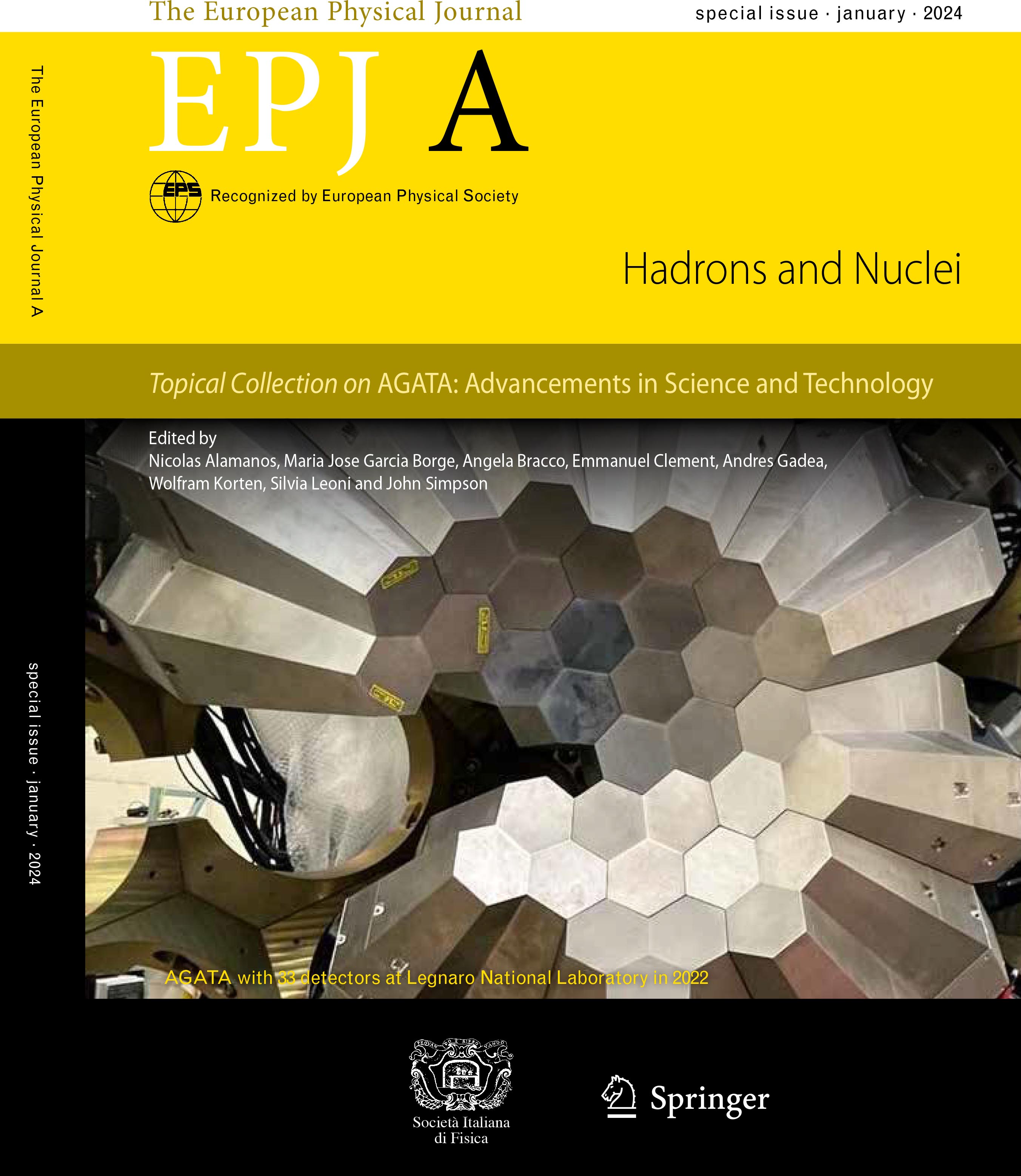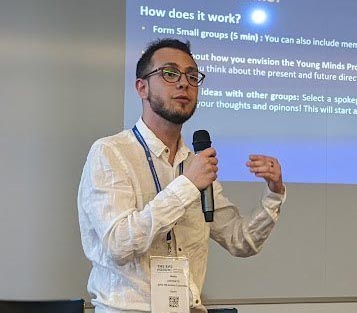News
EPJ A Topical Collection: AGATA: Advancements in science and technology
- Details
- Published on 24 January 2024

Guest Editors: Nicolas Alamanos, Maria Jose Garcia Borge, Angela Bracco, Emmanuel Clément, Andres Gadea, Wolfram Korten, Silvia Leoni and John Simpson
The Advanced GAmma Tracking Array (AGATA) is a major European project, involving over 40 institutes in 12 countries, to develop and operate a high-resolution gamma-ray tracking spectrometer. Gamma-ray tracking requires the accurate determination of the energy, time and position of every interaction as a gamma ray deposits its energy within the detector volume. This is achieved by using electrically segmented hyper pure germanium detectors, pulse shape analysis of the digitised signals, and tracking algorithms to reconstruct the full event. The AGATA 4π geometry comprises 180 tapered-hexagonal coaxial detectors. AGATA can measure gamma rays from 10’s of keV to 10 MeV with excellent efficiency and position resolution and has a very high count rate capability. These features result in an instrument with a resolving power of two orders of magnitude larger than previous spectrometers, such as EUROBALL in Europe and Gammasphere in the USA. A similar tracking spectrometer is being constructed in the USA, called GRETA.
EPJ B Highlight - Investigating the role of random walks in particle diffusion
- Details
- Published on 18 January 2024

Theoretical analysis reveals new insights into unusual patterns displayed by diffusing particles in recent experiments.
Several recent experiments identify unusual patterns in particle diffusion, hinting at some underlying complexity in the process which physicists have yet to discover. Through new analysis published in EPJ B, Adrian Pacheco-Pozo and Igor Sokolov at Humboldt University of Berlin show how this behaviour emerges through strong correlations between the positions of diffusing particles travelling along similar trajectories. Their results could help researchers to create better models of the diffusion process – ultimately drawing deeper insights into how fluids behave.
EPS Young Minds extends EPJ Scientific Advisory Committee as first Early Career Physics Network
- Details
- Published on 18 January 2024

The Steering Committee of EPJ is delighted to welcome Mattia Ostinato, as the representative of the EPS Young Minds. The EPS Young Minds is the first Early Career Physicists Network to join in a move to extend the traditional Scientific Advisory Committee with a broader range of professional scientific networks providing the EPJ publishers collectively with relevant expertise and perspectives on all aspects of scientific publishing
Mattia Ostinato is a PhD student at the University of Barcelona (UB), where he works in the field of molecular dynamics simulations for soft matter systems, with a focus on magnetically driven colloidal dynamics. He has been an EPS member since 2015, and is part of the EPS Young Minds Action Committee since 2020.
EPJ D Topical Issue: Dynamics and Photodynamics: From Isolated Molecules to the Condensed Phase
- Details
- Published on 17 January 2024

Guest Editors: Luis Bañares, Ramón Hernández-Lamoneda, Pascal Larregaray, Germán Rojas-Lorenzo and Jesús Rubayo-Soneira
Dynamics and photodynamics: from isolated molecules to the condensed phase is a highly interdisciplinary topical issue with numerous connections between traditional branches of physics and chemistry.
The issue provides a snapshot of current research in different areas of molecular systems science. It consists of 12 contributions representing both experimental and theoretical studies, ranging from fundamental mechanisms to more applied levels, which are essential in numerous applications of nanotechnology and material science. The contributions featured in this issue encompass a wide range of areas, including spectroscopy, photodissociation, dynamics of reactions involving neutral and charged cluster systems, carbon nanotubes and various other subjects.
This topical issue is celebrating the 20th anniversary of the Photodynamics Conference, held in Havana in November 2022.
All articles are available here and are freely accessible until 15 March 2024. For further information read the Editorial.
25 Years of EPJ – Supporting Early Career Researchers in 2023
- Details
- Published on 29 December 2023

2023 saw the 25th anniversary of the creation of the European Physical Journal (EPJ). To celebrate this landmark, one year ago the Steering Committee announced that EPJ would provide increased support of early career researchers, making a commitment to provide grants for young researcher meetings throughout the year.
The call for grant applications saw a great response, and we were delighted to be able to approve 23 of these conferences across a broad range of subjects including statistical physics, biophysics, optics, and high energy and particle physics. To meet the criteria, these were either meetings aimed specifically at young researchers, or included some session dedicated to early career scientists. The full list of supported young researcher conferences is given below, and spans meetings in Europe, the USA, India and South Africa.
EPJ E Colloquium - Convective mixing in porous media: A review of Darcy, pore-scale and Hele-Shaw studies
- Details
- Published on 19 December 2023

When a porous medium is filled with two fluid layers of different density, with the heavier fluid sitting on top of the lighter one, the system may become unstable. Due to the vertical density contrast, convective finger-like structures can form and accelerate fluid mixing. This configuration is representative of a variety of systems of practical interest, particularly in geophysical processes.
EPJ C: Francesco Forti new Editor-in-Chief for Experimental Physics I: Accelerator Based High-Energy Physics
- Details
- Published on 15 December 2023

The publishers of The European Physical Journal C – Particles and Fields are pleased to announce the appointment of Professor Francesco Forti as new Editor-in-Chief for Experimental Physics I: Accelerator Based High-Energy Physics, replacing Professor Günther Dissertori as of 1 January 2024.
Francesco Forti is Professor of Experimental Physics at the “Enrico Fermi” Physics Department of the Pisa University. His main scientific interests are in flavor physics and particle physics instrumentation. He is currently working in the Belle II collaboration at KEK and member of the ICFA Instrumentation, Innovation and Development Panel.
EPJ B: Prof. Dr. Reinhold Egger new Editor-in-Chief for the Condensed Matter section as of 1 January 2024
- Details
- Published on 15 December 2023

The publishers of The European Physical Journal B are pleased to announce the appointment of Prof. Dr. Reinhold Egger as new Editor-in-Chief for the Condensed Matter section of the journal as of January 1st, 2024.
Reinhold Egger has been a full professor of theoretical physics at Heinrich-Heine-Universität Düsseldorf since 2001. He has worked in many different areas of condensed matter physics, including nonequilibrium quantum transport, topological quantum matter, superconductivity and low-dimensional quantum field theory. He has been part of the board of EPJB since 2011 and he is recipient of the Gerhard-Hess-Preis of the DFG and of the Physics Prize of the Akademie der Wissenschaften zu Göttingen.
The publishers take the opportunity to thank wholeheartedly Dr. Eduardo Hernandez, for his dedicated work and leadership during his term as Editor-in-Chief of EPJB.
EPJ ST Highlight - An exciting era for ultrafast science in France
- Details
- Published on 15 December 2023

Progress across five scientific topics currently being investigated by the French scientific network on ultrafast phenomena highlight both a rapid pace of discovery and emerging new directions of research.
From biochemistry to quantum mechanics, ultrafast phenomena can be found across a broad array of scientific fields. Now the subject of a rapidly expanding area of research, they describe how matter behaves over timescales ranging from picoseconds (thousandths of a nanosecond), down to attoseconds (billionths of a nanosecond).
Today, ultrafast processes are studied by a global community of scientists, who are dedicated to understanding the inner workings of matter, and exploring how they can be controlled and exploited for novel applications. In 2023, three researchers were awarded the Nobel Prize in Physics for their contribution to attosecond laser technology: clearly emphasising the growing relevance of the field.
EPJ C Highlight - Celebrating 50 years of QCD with a comprehensive review
- Details
- Published on 13 December 2023

A series of key experiments performed about 50 years ago revealed the eminent role of gauge theories. Two theories were formulated: the electroweak theory and the strong interaction theory QCD. An extensive worldwide research programme has since been set up and has step by step corroborated their predictions, while alternative theoretical attempts have been ruled out. Today these theories are well established and represent the cornerstones of the Standard Model.
The main authors, Franz Groß and Eberhard Klempt, succeeded in gathering experts to write articles covering all aspects of the vast field of strong interaction processes, described by Quantum Chromodynamics QCD, the theory of strong interactions. The fruit of their labours is a comprehensive review, ca. 650 pages long, published in the European Physical Journal C (EPJ C). The major aspects are outlined in 14 chapters, each of which is devoted to a specific topic. The authors’ goal was to provide general and detailed insights into both experiment and theory, for the benefit of research students and other interested readers alike.





